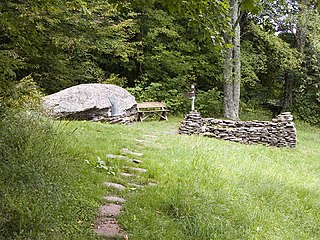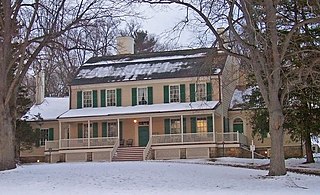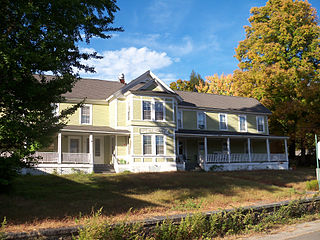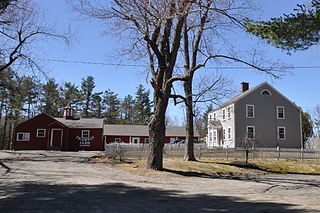
This is intended to be a complete list of properties and districts listed on the National Register of Historic Places in Orleans County, New York. The locations of National Register properties and districts may be seen in a map by clicking on "Map of all coordinates". Two listings, the New York State Barge Canal and the Cobblestone Historic District, are further designated a National Historic Landmark.

Castle Hill is a 56,881 sq ft (5,284.4 m2) Tudor Revival mansion in Ipswich, Massachusetts built 1926-1928 as a summer home for Mr. and Mrs. Richard Teller Crane, Jr. It is also the name of the 165-acre (67 ha) drumlin surrounded by sea and salt marsh the home was built atop. Both are part of the 2,100-acre (850 ha) Crane Estate located on Argilla Road. The estate includes a historic mansion, 21 outbuildings, and landscapes overlooking Ipswich Bay, on the seacoast off Route 1, north of Boston. Its name derives from a promontory in Ipswich, Suffolk, England, from which many early Massachusetts Bay Colony settlers immigrated.

Woodchuck Lodge is a historic house on Burroughs Memorial Road in a remote part of the western Catskills in Roxbury, New York. Built in the mid-19th century, it was the last home of naturalist and writer John Burroughs (1837-1921) from 1908, and is the place of his burial. The property is now managed by the state of New York as the John Burroughs Memorial State Historic Site, and the house is open for tours on weekends between May and October. The property is a National Historic Landmark, designated in 1962 for its association with Burroughs, one of the most important nature writers of the late 19th and early 20th centuries.

The John Jay Homestead State Historic Site is located at 400 Jay Street in Katonah, New York. The site preserves the 1787 home of statesman John Jay (1745–1829), one of the three authors of The Federalist Papers and the first Chief Justice of the United States. The property was designated a National Historic Landmark in 1981 for its association with Jay. The house is open year-round for tours.

Montgomery Place, now Bard College: The Montgomery Place Campus, near Barrytown, New York, United States, is an early 19th-century estate that has been designated a National Historic Landmark. It is also a contributing property to the Hudson River Historic District, itself a National Historic Landmark. It is a Federal-style house, with expansion designed by architect Alexander Jackson Davis. It reflects the tastes of a younger, post-Revolutionary generation of wealthy landowners in the Livingston family who were beginning to be influenced by French trends in home design, moving beyond the strictly English models exemplified by Clermont Manor a short distance up the Hudson River. It is the only Hudson Valley estate house from this era that survives intact, and Davis's only surviving neoclassical country house.

Owl's Nest, also known as the Edward Eggleston Estate, is a historic estate property located on the shore of Lake George in Queensbury, New York. Developed in the 1870s and 1880s, it was the home of Edward Eggleston (1837-1902), one of America's first realist writers. He began summering there in the 1870s and it was his permanent home from the mid-1880s until his death. The property was declared a National Historic Landmark in 1971.

Shadow Lawn is a historic building on the campus of Monmouth University in West Long Branch, Monmouth County, New Jersey, United States. Built in 1927 for Hubert T. Parson, president of the F.W. Woolworth Company, it is one of the last large estate houses to be built before the Great Depression. It was designated a National Historic Landmark in 1985 for its architecture.
The Coons House is located along NY 9G in Clermont, New York, United States, across the road from the Clarkson Chapel. It was built in the mid-19th century in the Greek Revival architectural style.

There are 71 properties listed on the National Register of Historic Places in Albany, New York, United States. Six are additionally designated as National Historic Landmarks (NHLs), the most of any city in the state after New York City. Another 14 are historic districts, for which 20 of the listings are also contributing properties. Two properties, both buildings, that had been listed in the past but have since been demolished have been delisted; one building that is also no longer extant remains listed.
Wilbur House is a historic home located on Main Street in Fairport in Monroe County, New York. It is a Second Empire–style structure built about 1873 that features a two-bay, 2-story tower that projects from the northeast corner of the 1+1⁄2-story front section. The tower, as well as the rest of the front section, is covered by a decorative fish scale and octagonal slate mansard roof. Also on the property is a contributing carriage house.

Seven Oaks Estate, the former Charles F. Park estate, is a historic estate located at Palisades in Rockland County, New York. The main estate house is a large clapboarded structure built in 1862 in the Gothic Revival style. The house features a projecting central bay and full-width verandah. Also on the property are a coachman's house, built about 1862, and four subsidiary outbuildings.

Home Farm, also known as the Mirriam-Bartholomew House, is a historic home and farm complex located at East Whitehall in Washington County, New York. The house was built about 1840 and consists of a two-story, five bay, center entrance brick main block with a rear brick kitchen wing in the Greek Revival style. The farm complex has 17 contributing resources including a frame cow barn complex, a timber frame horse and carriage barn, a light frame creamery, a light-frame sugar house, and a brick smoke house.

Spring House is a historic inn located at Barryville in Sullivan County, New York. It was built as a residence about 1880 and almost immediately enlarged as a hotel and boarding house. The original house is the 2-story main block with gable roof, a small south gable-roofed wing, and a two-by-two-bay rear wing. Long narrow wings were added shortly after the original construction. It is now configured as a long, narrow, rectangular building, two stories tall, eleven bays wide and two bays wide with a 2+1⁄2-story cross-gabled center section.

Godillot Place is a historic country estate at 60 and 65 Jesup Road in Westport, Connecticut. The main house, now known as the Lyman Building, built c. 1880 around an 1804 farmhouse, is Westport's best example of Stick style architecture. The estate also includes a late 19th-century carriage house and guest cottage, all now owned by the town. The property was listed on the National Register of Historic Places in 1977.

Bryant Fleming House is a historic home located at Wyoming in Wyoming County, New York. It was built about 1850 and is a 1+1⁄2-story, two-by-three-bay cross-gabled vernacular Italianate-style cottage with a two-by-three-bay, 1-story rear wing. Another main building is a multi-purpose "playhouse" designed for large-scale entertaining and accommodation of overnight guests. The property includes notable landscape features that its principal owner, Bryant Fleming (1877–1946) designed and installed after he purchased the property about 1910. Also on the property is a small decorative pool with fountain, two sets of stone and concrete steps, a garden gate, and brick walls with gate posts.

John E. Aldred Estate, also known as St. Josaphat's Monastery, is a historic estate located at Lattingtown in Nassau County, New York. It was designed in 1916 by architect Bertram Goodhue, with landscaping by Olmsted Brothers, for public utility executive John Edward Aldred.

Henry Tunis Smith Farm, also known as the Middlebrook Farm, is a historic farmhouse located at Nassau in Rensselaer County, New York. The house was built in 1789 in the Federal style. It consists of a 1+1⁄2-story main block, five bays wide, with a 1-story, three-bay wing. The front facade features a finely detailed frieze.

Maple Grove is a historic estate located at Poughkeepsie, Dutchess County, New York. The estate consists of eight contributing buildings: the main house, farmer's cottage, barn, carriage barn, garage, shed, and two cottages. Also on the property is a pair of contributing sandstone gateposts. The main house was built in 1850 in the Italianate style and remodeled in 1891. It is constructed of painted red brick and has a 2+1⁄2-story, three-bay, main block flanked by 2-story, three-bay-wide wings. It has a large, 2-story rear kitchen wing. It features a prominent 1-story open wood porch.

The Asa Morse Farm, also known as the Friendly Farm, is a historic farmstead on New Hampshire Route 101 in Dublin, New Hampshire. The main farmhouse, built in 1926 on the foundations of an early 19th-century house, is a good example of Colonial Revival architecture, built during Dublin's heyday as a summer retreat. The farmstead was listed on the National Register of Historic Places in 1983.

Reverie Cove is a historic summer estate on Harbor Lane in Bar Harbor, Maine. It was designed by local architect Fred L. Savage and built in 1895, and is a particularly opulent example of Colonial Revival architecture. A later owner of the property was New York City mayor Abram Hewitt. The house was listed on the National Register of Historic Places in 1982, and as part of the Harbor Lane-Eden Street Historic District in 2009.






















